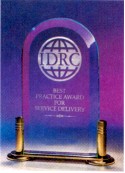Whirlpool:
RE Takes ‘Integrator’ Role
b y J A C K L Y N E
Features
Whirlpool:
RE Takes ‘Integrator’ Role
b y J A C K L Y N E
Consistent, quantifiable processes and savvy outsourcing are two of the keys in the dawning rise of Whirlpool’s Corporate Real Estate (CRE) unit into the role of “corporate integrator” — a value-adding effort that bagged a prestigious 1999 Best Practices Award in Leadership from the International Development Research Council (IDRC), the world’s preeminent corporate real estate association. No wonder. The effort at Whirlpool (www.whirlpool.com) reflects IDRC’s strong emphasis on Corporate Infrastructure ResourceSM Management.

CRE’s ascent as an infrastructure integration leader has rested in a commonsensical, but vital, notion: integrating the workplace, a value-adding approach that also requires a blending of real estate, human resources, technology and business processes.
Accordingly, CRE has integrated all traditional real estate functions into a single life-cycle concept, and it’s melding its strategies with those of the corporation and its business units.
In addition, CRE strategies are now being developed as part of a finance strategy, which includes eliminating the widespread but wrongheaded notion that space is “free.” CRE instead is serving up a strong dose of leadership, driving accountability by allocating space costs to business unit users.
Richly Detailed Data
Strong leadership, though, is a prerequisite, given a miniscule staff managing 338 worldwide locations totaling 41.4 million sq. ft. (3.73 million sq. m.).
“The key to managing Whirlpool’s global [CRE] holdings with only eight employees is having a consistent process in place where all the information needed is instantly available to everyone,” says CRE Director Carl Nedderman.
CRE’s global database, in fact, contains transactional, operational and financial metrics for all 338 properties. The database tracks such a broad data range for each site that it can instantly generate customized reports (e.g., comparative site analyses).
Savvy Outsourcing, Strong Metrics
That database alone, though, can’t provide the consistent process, much less sufficient people, to manage the home appliance giant’s sprawling portfolio. That’s where savvy outsourcing comes in.
CRE began its strategic outsourcing effort in 1997 at Whirlpool’s Benton Harbor, Mich., headquarters. That project proved so successful that the initiative has been extended into a pilot program in manufacturing, where Whirlpool’s true competitive edge lies.
CRE added to outsourcing’s competitiveness by selecting a single global service provider with complementary competencies: Los Angeles-based CB Richard Ellis (www.cbcommercial.com).
“Manufacturing appliances is one of Whirlpool’s core competencies. Industrial cleaning, roof repairs, janitorial work, rolling stock management and related areas are not,” Nedderman says. “CB Richard Ellis has systems and processes already in place to manage those kinds of items better than Whirlpool.
“They’ve brought discipline to our procedures and put in place a process that saves the company money and is applicable to other functions as well,” he continues. “Areas that directly impact the manufacturing process aren’t touched.”
CRE also set up strong performance metrics. Those metrics are the foundation for the “balanced scorecard” that the CRE team compiles (and reviews quarterly) to quantify how real estate is supporting corporate objectives. CRE’s “financial scorecard,” for example, measures total economic value added, plus cash flow and profitability impacts.
Costs, though, are only part of the picture. CRE, says Nedderman, faces a “double challenge”: reducing real estate costs, but also improving workplace environments and enhancing productivity for Whirlpool’s 58,000-plus employees. Accordingly, CRE is teaming with business units to implement alternative workplace initiatives that improve asset utilization and space capacities.
Similarly, Steve Rush, Whirlpool North America manager of corporate indirect goods and services, notes that “outsourcing has added value; it isn’t a reduce-costs-at-any-cost idea. If it doesn’t fit at a particular location, then we look in other directions.”
‘Even More Value Can Be Added’
While productivity remains a thorny empirical nut, CRE’s 1998 results bespeak value-adding leadership: US$49 million in total net present value in transaction savings; $34.1 million in cash flow from dispositions, and $1.8 million in savings from the CB Richard Ellis facilities and administration contract.
That’s only a start, though. CRE is moving toward implementing more U.S. manufacturing outsourcing, and it’s considering a pilot European program.
“We see that even bigger cost reductions and more value can be added by utilizing and applying the principles used by CB Richard Ellis to the production side,” Nedderman says.
SS